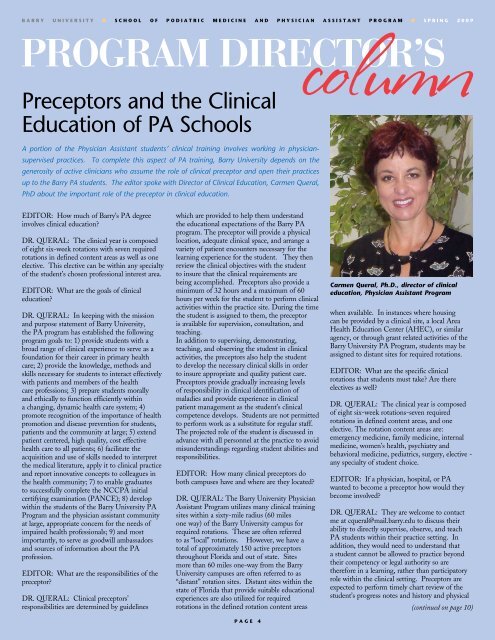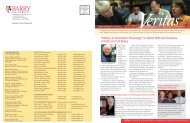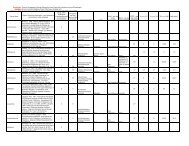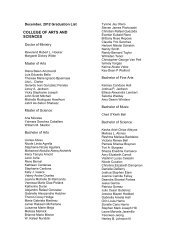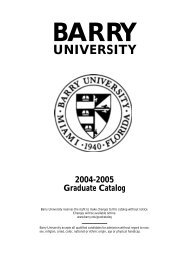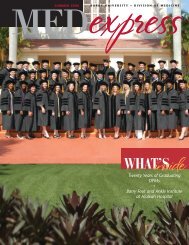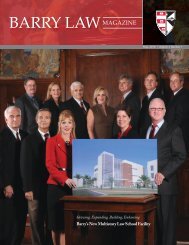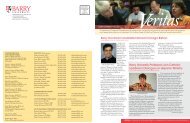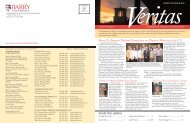Spring 2009 - Barry University
Spring 2009 - Barry University
Spring 2009 - Barry University
Create successful ePaper yourself
Turn your PDF publications into a flip-book with our unique Google optimized e-Paper software.
<strong>Barry</strong> <strong>University</strong> n School of Podiatric Medicine and Physician Assistant Program n spring <strong>2009</strong><br />
Program DIRECTOR’S<br />
Preceptors and the Clinical<br />
Education of PA Schools<br />
A portion of the Physician Assistant students’ clinical training involves working in physiciansupervised<br />
practices. To complete this aspect of PA training, <strong>Barry</strong> <strong>University</strong> depends on the<br />
generosity of active clinicians who assume the role of clinical preceptor and open their practices<br />
up to the <strong>Barry</strong> PA students. The editor spoke with Director of Clinical Education, Carmen Queral,<br />
PhD about the important role of the preceptor in clinical education.<br />
EDITOR: How much of <strong>Barry</strong>’s PA degree<br />
involves clinical education?<br />
DR. QUERAL: The clinical year is composed<br />
of eight six-week rotations with seven required<br />
rotations in defined content areas as well as one<br />
elective. This elective can be within any specialty<br />
of the student’s chosen professional interest area.<br />
EDITOR: What are the goals of clinical<br />
education?<br />
DR. QUERAL: In keeping with the mission<br />
and purpose statement of <strong>Barry</strong> <strong>University</strong>,<br />
the PA program has established the following<br />
program goals to: 1) provide students with a<br />
broad range of clinical experience to serve as a<br />
foundation for their career in primary health<br />
care; 2) provide the knowledge, methods and<br />
skills necessary for students to interact effectively<br />
with patients and members of the health<br />
care professions; 3) prepare students morally<br />
and ethically to function efficiently within<br />
a changing, dynamic health care system; 4)<br />
promote recognition of the importance of health<br />
promotion and disease prevention for students,<br />
patients and the community at large; 5) extend<br />
patient centered, high quality, cost effective<br />
health care to all patients; 6) facilitate the<br />
acquisition and use of skills needed to interpret<br />
the medical literature, apply it to clinical practice<br />
and report innovative concepts to colleagues in<br />
the health community; 7) to enable graduates<br />
to successfully complete the NCCPA initial<br />
certifying examination (PANCE); 8) develop<br />
within the students of the <strong>Barry</strong> <strong>University</strong> PA<br />
Program and the physician assistant community<br />
at large, appropriate concern for the needs of<br />
impaired health professionals; 9) and most<br />
importantly, to serve as goodwill ambassadors<br />
and sources of information about the PA<br />
profession.<br />
EDITOR: What are the responsibilities of the<br />
preceptor?<br />
DR. QUERAL: Clinical preceptors’<br />
responsibilities are determined by guidelines<br />
which are provided to help them understand<br />
the educational expectations of the <strong>Barry</strong> PA<br />
program. The preceptor will provide a physical<br />
location, adequate clinical space, and arrange a<br />
variety of patient encounters necessary for the<br />
learning experience for the student. They then<br />
review the clinical objectives with the student<br />
to insure that the clinical requirements are<br />
being accomplished. Preceptors also provide a<br />
minimum of 32 hours and a maximum of 60<br />
hours per week for the student to perform clinical<br />
activities within the practice site. During the time<br />
the student is assigned to them, the preceptor<br />
is available for supervision, consultation, and<br />
teaching.<br />
In addition to supervising, demonstrating,<br />
teaching, and observing the student in clinical<br />
activities, the preceptors also help the student<br />
to develop the necessary clinical skills in order<br />
to insure appropriate and quality patient care.<br />
Preceptors provide gradually increasing levels<br />
of responsibility in clinical identification of<br />
maladies and provide experience in clinical<br />
patient management as the student’s clinical<br />
competence develops. Students are not permitted<br />
to perform work as a substitute for regular staff.<br />
The projected role of the student is discussed in<br />
advance with all personnel at the practice to avoid<br />
misunderstandings regarding student abilities and<br />
responsibilities.<br />
EDITOR: How many clinical preceptors do<br />
both campuses have and where are they located?<br />
DR. QUERAL: The <strong>Barry</strong> <strong>University</strong> Physician<br />
Assistant Program utilizes many clinical training<br />
sites within a sixty-mile radius (60 miles<br />
one way) of the <strong>Barry</strong> <strong>University</strong> campus for<br />
required rotations. These are often referred<br />
to as “local” rotations. However, we have a<br />
total of approximately 150 active preceptors<br />
throughout Florida and out of state. Sites<br />
more than 60 miles one-way from the <strong>Barry</strong><br />
<strong>University</strong> campuses are often referred to as<br />
“distant” rotation sites. Distant sites within the<br />
state of Florida that provide suitable educational<br />
experiences are also utilized for required<br />
rotations in the defined rotation content areas<br />
page 4<br />
Carmen Queral, Ph.D., director of clinical<br />
education, Physician Assistant Program<br />
when available. In instances where housing<br />
can be provided by a clinical site, a local Area<br />
Health Education Center (AHEC), or similar<br />
agency, or through grant related activities of the<br />
<strong>Barry</strong> <strong>University</strong> PA Program, students may be<br />
assigned to distant sites for required rotations.<br />
EDITOR: What are the specific clinical<br />
rotations that students must take? Are there<br />
electives as well?<br />
DR. QUERAL: The clinical year is composed<br />
of eight six-week rotations-seven required<br />
rotations in defined content areas, and one<br />
elective. The rotation content areas are:<br />
emergency medicine, family medicine, internal<br />
medicine, women’s health, psychiatry and<br />
behavioral medicine, pediatrics, surgery, elective -<br />
any specialty of student choice.<br />
EDITOR: If a physician, hospital, or PA<br />
wanted to become a preceptor how would they<br />
become involved?<br />
DR. QUERAL: They are welcome to contact<br />
me at cqueral@mail.barry.edu to discuss their<br />
ability to directly supervise, observe, and teach<br />
PA students within their practice setting. In<br />
addition, they would need to understand that<br />
a student cannot be allowed to practice beyond<br />
their competency or legal authority so are<br />
therefore in a learning, rather than participatory<br />
role within the clinical setting. Preceptors are<br />
expected to perform timely chart review of the<br />
student’s progress notes and history and physical<br />
(continued on page 10)


